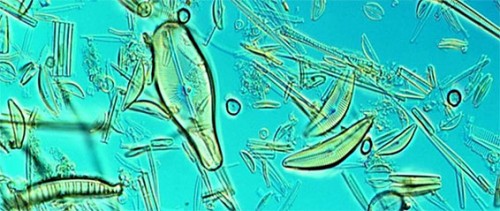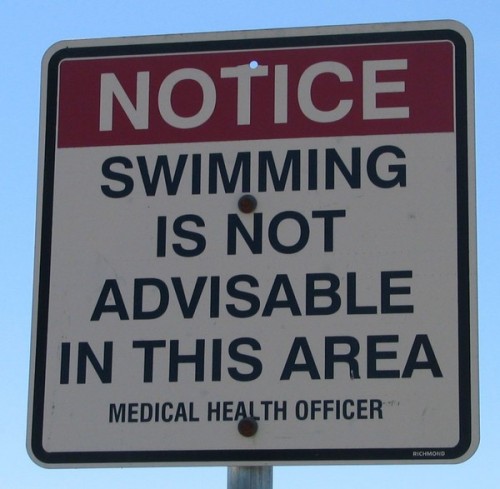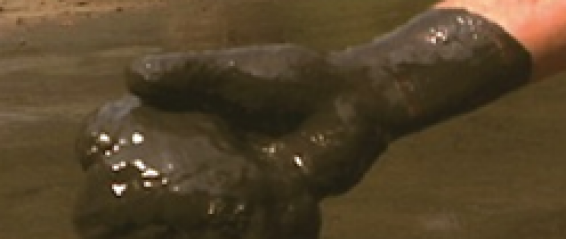Aerobic Bacteria: Nature’s Rapid Muck Digesters
Get Rid of the Compost Pile at the Bottom of Your Lake
The “muck” that accumulates at the lake-bottom is organic compost that cannot be broken down fast enough. This is a sign that your lake is overloaded with nutrients and simply can’t keep up with the amount of decaying weeds, algae, leaves, feces and other organic material piling up on the bottom every year.
Muck is a sign that your lake is severely out of balance. The first step in restoring that balance is to increase dissolved oxygen in the water column and to the “compost pile” at the bottom. The second step is to biologically accelerate the healthy (and normal) decomposition of the muck.
Nature again provides the answer in the form of beneficial aerobic bacteria that can literally eat the muck and convert it into more bacteria, carbon dioxide and water. These bacteria are then eaten by other micro-organisms and insects which, in-turn, are eaten by fish.
This is a healthy natural process that can deliver results quickly. We are consistently reducing lake-bottom muck by one foot per season by unleashing these powerful “bottom-cleaners” in combination with Lake Bottom Aeration. The end result is a clean lake-bottom and bigger healthier fish!
“Good” Bacteria Versus “Bad” Bacteria
There are essentially two ways that a lake digests the organic muck coating the bottom – aerobic digestion and anaerobic digestion. Aerobic digestion is fast and it’s good for the lake. Anaerobic digestion is not only bad for the lake; it’s harmful to fish and other beneficial organisms and potentially harmful to humans.
Oxygen makes a rapid muck reduction possible.
When there is sufficient oxygen at the bottom of the lake, aerobic bacteria and other microorganisms that feed on organic muck thrive. In fact, oxygenating the lake-bottom binds up to 97% of the phosphorus and nitrogen in the water to the bottom sediment where it becomes food for beneficial, muck consuming bacteria and insects. Without oxygen these beneficial organisms can’t survive to do the work of rapid muck reduction. This is why Lake Bottom Aeration is the critical first step in reviving your lake.
We accelerate the lake’s natural muck digestion process by adding aerobic bacteria which immediately and exponentially increases their population on the bottom of the lake.
Once the population of aerobic bacteria is boosted and supported by Lake Bottom Aeration, we make it easier for them to digest/metabolize phosphorous and nitrogen by adding vegetable-based enzymes which soften/break down the tough cellular walls of dead organic matter. In fact, we put aerobic digestion of muck – and the reduction of phosphorous and nitrogen which fuel weed and algae growth – into hyperdrive.
Our Rapid Muck Reduction Bio-Augmentation Products
Clean & Clear Concentrated Enzymes™
Clean & Clear Concentrated Enzymes is a special blend of non-toxic vegetable enzymes from nature that acts as a catalyst to biodegrade non-living organic matter and reduce available nutrients in the water, thus improving water quality. Clean & Clear softens the cell walls of dead organic matter making it easier for beneficial bacteria to feed. In essence, these enzymes give the bacteria a “jump start” in digesting lake-bottom muck. Clean & Clear also reduces odor caused by toxic gases from pathogenic (disease-type) bacteria, including hydrogen sulfide, ammonia, amines and mercaptans. Clean & Clear provides the following benefits:
- Accelerates bio-degradation of organic matter
- Helps beneficial aerobic bacteria compete with anaerobic bacteria, thereby reducing phosphorus and nitrogen which fuel weed and algae growth. Helps liquefy organic waste.
- Improves water quality
- Reduces odors, including animal manure odors; improves air quality
- Safe to use; no health problems
- Safe in the environment; no pollution concerns
- Safe around animals
- Easy to apply economical to use
C-FLO Living Organisms
 Description: C-FLO is a special formulation of beneficial microorganisms that feed on organic sediment (muck) at the bottom of ponds and lakes. These organisms are found in the woods feeding on dead leaves, bark, weeds and other dead matter. When you walk through the woods, you step on as many as 300,000,000 of these tiny organisms with every step. C-FLO is comprised of healthful organisms that are natural food for aquatic insects. C-FLO multiplies as it feeds on organic sediment, and insects grow and multiply as they feed on C-FLO. Fish then feed on the insects and grow rapidly.
Description: C-FLO is a special formulation of beneficial microorganisms that feed on organic sediment (muck) at the bottom of ponds and lakes. These organisms are found in the woods feeding on dead leaves, bark, weeds and other dead matter. When you walk through the woods, you step on as many as 300,000,000 of these tiny organisms with every step. C-FLO is comprised of healthful organisms that are natural food for aquatic insects. C-FLO multiplies as it feeds on organic sediment, and insects grow and multiply as they feed on C-FLO. Fish then feed on the insects and grow rapidly.
What C-FLO does: C-FLO feeds on bottom organic muck, ooze, and peat, digesting and converting it to carbon dioxide and water. As C-FLO feeds on bottom muck, the lake will deepen, creating a better environment for fish, and less opportunity for weeds to grow. Cattails and lilies will gradually disappear. This process replaces dredging the organic material at a tiny fraction of the cost. C-FLO is harmless to fish, wildlife, pets, humans, and the environment when used as directed. As mentioned above, the sediment decomposition process is accelerated by the addition of oxygen breathing microorganisms. These organisms have been exempted from the need to be registered for use in lakes by the U.S. Environmental Protection Agency because of their beneficial and harmless nature.
Where it can be used: C-FLO will only work in ponds and lakes that are continuously oxygenated and rid of hydrogen sulfide (rotten egg smell when the bottom is stirred up). If oxygen runs out or hydrogen sulfide rises for even a few days, the organisms may die and your pond or lake will need a new application. Therefore, for best results C-FLO should be used with Clean & Clear Concentrated Enzymes and Lake Bottom Aeration.
Lack of Oxygen Produces “Bad” Bacteria that can Kill Your Lake
When the bottom of the lake is layered with dead organic matter (muck) and weeds and algae choke the surface of the lake, it means there is not enough oxygen on the lake-bottom to sustain a thriving and productive population of aerobic bacteria. In fact, when oxygen is absent, anaerobic bacteria take over.
 Anaerobic bacterial digestion breaks down organic matter much slower and produces acids which not only decrease water quality, but also cause a massive release of phosphorus and nitrogen from the organic sediment – the two major nutrients which fuel excess weed and algae growth. Anaerobic bacteria also produce toxic gases such as ammonia, methane, and hydrogen sulfide (the rotten egg smell).
Anaerobic bacterial digestion breaks down organic matter much slower and produces acids which not only decrease water quality, but also cause a massive release of phosphorus and nitrogen from the organic sediment – the two major nutrients which fuel excess weed and algae growth. Anaerobic bacteria also produce toxic gases such as ammonia, methane, and hydrogen sulfide (the rotten egg smell).
If your lake-bottom sediment smells like rotten eggs or “swamp gas” it’s a sure sign anaerobic bacterial digestion is at work. Worse, anaerobic bacteria include pathogenic (disease-producing) bacteria. These diseases include cholera, scabies, typhoid, shigella, salmonella, botulism and miscellaneous bacteria that cause infectious boils and sores.
Photo credit: Stephen Rees / Foter.com / CC BY-NC-ND
























